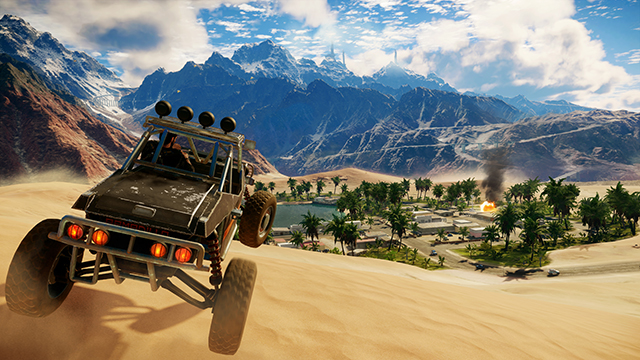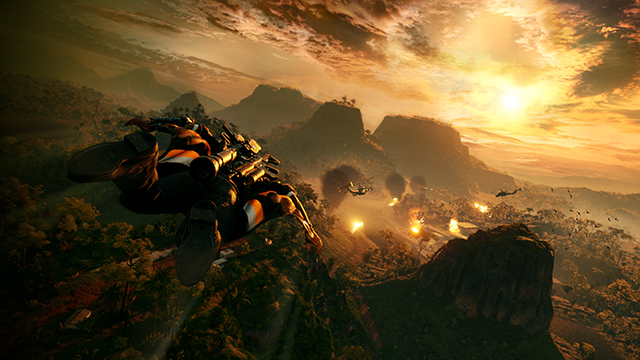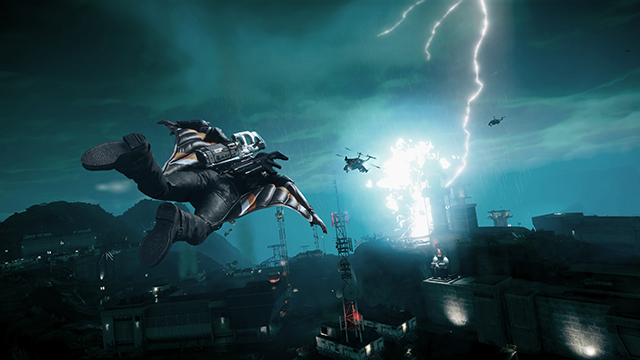A few months ago, I wrote that Just Cause 4 was a “dumber, more dynamic sandbox” based on a live, hands-off presentation. I finally got to play that same demo and it was as wild, hilarious, and unpredictable as it seemed. The random debris crushed me more than a few times and it, combined with the new wind physics, already felt like the best sandbox the series has seen in its 12-year history. But developer Avalanche Studios wants to also focus on Rico Rodriguez’s story this time around and how it weaves into the ridiculous action. We recently got to sit down with Narrative Director Omar Shakir (and Senior Producer Victoria Setian) to talk about making Just Cause 4‘s narrative fit between and enhance the Mission Impossible-level stunts and explosions.
Game Revolution: So how do you put in a narrative in a series mostly about blowing things up?
Omar Shakir: Narrative was really important to us this time around in Just Cause 4. We want to tell a better, bigger story. Everybody asks us about extreme and think that we just wanted to up the ante. And the truth was extreme weather wasn’t immediately the thing we wanted to do. One of the things our game director Francesco Antolini always says is that when you make a sandbox, just like a surfer, it’s not about providing a surfer with more water, it’s about providing a surfer with better waves.
And that’s kind of how we design our sandboxes over at Avalanche Studios. So when they were coming up with things like the wind system and river currents, we always like to present the player with the sort of polar extremes. We give light winds and river currents but then show you the extreme version of that. So naturally the evolution of extreme wind became the tornado. So it became how do you contextualize the idea of extreme wind? We don’t just want fast-moving wind currents. We want something that looks like a challenge and something you can use in the sandbox.
That’s where the idea for the tornado, extreme river currents, lightning storms, torrential rain, and things like that came from. And then we needed the engine to do it, which, in 15 years of sandbox experience, we were able to perfect this Apex engine that allowed us to do all these systemic open-world sandbox moments.
From a narrative perspective, when it started to evolve into tornadoes, lightning storms, and sandstorms, my first thought was sort of like ‘OK that’s sort of a challenge. Rico has always been a force of nature himself.’ And then it hit me. Bullets and rockets have never really had an effect on Rico. But what happens when one force of nature like Rico Rodriguez meets an actual force of nature? So the story began to evolve from there.
It was a challenge at first to contextualize it but once we arrived what we arrived at, it actually seemed like the perfect adversary in a lot of ways but also the perfect sandbox tool for the player. Whenever we can have gameplay and story coalesce like that, it usually leads to a very unique experience.

GR: When seeing the game, I wasn’t sure if the story would go down the Doom (2016) route of being this incredibly smart, self-aware story that knew what it was and leaned into it. It would make sense with all these bombast of the Just Cause series.
Shakir: Even with Doom and us, the story is actually everywhere in the game. While we may not be communicating it in every moment like, say, a cutscene or cinematic, the way we build the world, the fictional South American world of Solis, we built a narrative from the ground up to provide context to the player. Because scale and scope is everything. So if the player can understand the story of this fictional South American world when they jump in without a cutscene, then we’ve done our job.
For example, we were at the Slum Bridge. That’s a very unique location in the game. It’s like a favela shanty village built into this broken down bridge which used to be train tracks. There’s is a narrative that exists in the game world about why that location is even there in the first place. How did it turn into that? What happened to the people that live there? Who lives there? Why do they live there? So the narrative is always happening even in a Just Cause game whether you’re in cinematic or not.
And that’s actually where we start. When we build the world, we start by saying ‘What is this place? What do people do here? How do people get to work? How do they get to work from this location? Where do they work?’
This time around for Rico we tried to do was give more context to the chaos and explore a little bit of his character of why he does what he does. And a lot of the ways we do that is through the characters he meets along the story. They begin to ask him these questions about why he does what he does and what that means for them. And you’ll see that as we hint at more parts of the story. We haven’t shown much of it yet.

GR: Yes, and that’s why this is difficult to ask about because, understandably, you all haven’t shown much story stuff about this game. It’s just been mainly about the grappling hook and extreme weather. But I can at least see how you’re attempting to make the gameplay and story linked together.
Shakir: Yes, this is the home of the Black Hand and that’s an enemy force that Rico has encountered in the past. The question becomes why have they been a recurring theme in his life and what does that mean for the story now that he is on their home turf? And it’s some of those things that we’re excited that the player will discover along the story about they are connected.
GR: Just Cause 3 had a few add-ons that added some inventive gadgets like the Bavarium Wingsuit and Loochador Rocket Boat. Is that stuff going to be in Just Cause 4?
Shakir: Players loved that. And going back to the waves analogy, we like to ground the physics as much as possible even though it is about the player creatively behaving. And for use, creating wind currents, it was a more interesting opportunity than giving them an unlimited wingsuit. So now you can ride the wind currents, you feel it catch you. So that was the direction we took with Just Cause 4.
It is a balancing act but I think our players will find [more joy in] the systemic wind currents like the tornado, the wind gun, the lightning storms, and the sandstorms we haven’t even talked about yet. The wind is a theme everywhere. Our goal was that the player won’t miss the Bavarium Wingsuit because they’ll be riding cool waves that we’ve created.
The team has done an incredible job placing volumes of air all over the world and giving more context to Rico’s wingsuit. It’s always about making the player feeling somewhat challenged so when they pull of that insane moment, it wasn’t because there was a particular mechanic that was helping them do it, it was because of their mastery over the wingsuit and parachute.

GR: The grappling hook has always been a pivotal part of the series? Can you talk a bit more about that?
Victoria Setian (Senior Producer): There are three different retooler grappling hook abilities and there are modifications for each type. So there is only three abilities for the grappling but we actually sat down and did the math and the number of modification combinations is 4 million. So our demo only scratched the surface of what the grappling hook could do.
Shakir: We have an economy that the player progresses to get some unlocks. In JC3, they unlocked through challenges. But the feedback we got from players was it wasn’t their favorite thing so we came up with a different way to unlock them. We do want to make sure players get a chance to play with everything. So the system we came up with goes into story and it’s more closely tied to what is happening on the island than in JC3 where you were just doing challenges to get upgrades.
Also Rico in four games has had this grappling hook and it seems strange that we haven’t acknowledged that. In JC4, we talk about Rico relationship to this grappling hook. So this is where is the air lifter and retractor come from. We can’t wait to show you more.
GR: …Is his wife the grappling hook?
Shakir: [laughs] Well, one would say it is attached to him at the arm…











